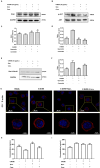Quercetin Attenuates MRGPRX2-Mediated Mast Cell Degranulation via the MyD88/IKK/NF-κB and PI3K/AKT/ Rac1/Cdc42 Pathway
- PMID: 39398230
- PMCID: PMC11468308
- DOI: 10.2147/JIR.S480644
Quercetin Attenuates MRGPRX2-Mediated Mast Cell Degranulation via the MyD88/IKK/NF-κB and PI3K/AKT/ Rac1/Cdc42 Pathway
Abstract
Background: CMRF35-like molecule-1 (CLM-1) is a receptor of the CD300 family that inhibits MRGPRX2-mediated mast cell degranulation. Understanding the role and mechanism of CLM-1 agonist has significant implications for the treatment of allergic disease. Quercetin is a natural small molecule compound derived from plants and vegetables that has been shown to prevent histamine release by immune cells.
Objective: This study aims to examine the inhibitory effects of quercetin on MRGPRX2-mediated mast cell degranulation via CLM-1.
Results: We found that C48/80 stimulation resulted in significantly increased release of β-hexosaminidase, histamine and Ca2+ in CLM-1-knockdown LAD2 cells than in NC-LAD2 cells. Surface plasmon resonance (SPR) and molecular docking analyses revealed high-affinity binding between quercetin and CLM-1 (K D = 2.962×10-5 mol/L) mediated by the formation of hydrogen bonds. In addition, quercetin can selectively bind to CLM-1 on mast cells, leading to SHP-1 phosphorylation and subsequent inhibition of downstream MyD88/IKK/NF-κB signaling. Furthermore, activation of CLM-1 modulated the surface expression of MRGPRX2 by inhibiting F-actin, leading to internalization of the MRGPRX2 receptor via the PI3K/AKT/ Rac1/Cdc42 pathway.
Conclusion: Quercetin is a promising treatment for allergic diseases by acting as a CLM-1 agonist that inhibits MRGPRX2-mediated mast cell degranulation.
Keywords: CLM-1; MRGPRX2; inhibition; mast cell degranulation; quercetin.
© 2024 Zhao et al.
Conflict of interest statement
The authors declare that they have no known competing financial interests or personal relationships that could have appeared to influence the work reported in this paper.
Figures






Similar articles
-
Quercetin inhibits Mrgprx2-induced pseudo-allergic reaction via PLCγ-IP3R related Ca2+ fluctuations.Int Immunopharmacol. 2019 Jan;66:185-197. doi: 10.1016/j.intimp.2018.11.025. Epub 2018 Nov 21. Int Immunopharmacol. 2019. PMID: 30471617
-
Caffeic acid phenethyl ester inhibits pseudo-allergic reactions via inhibition of MRGPRX2/MrgprB2-dependent mast cell degranulation.Arch Pharm Res. 2022 Sep;45(9):644-657. doi: 10.1007/s12272-022-01405-2. Epub 2022 Oct 2. Arch Pharm Res. 2022. PMID: 36183260
-
MrgprX2 regulates mast cell degranulation through PI3K/AKT and PLCγ signaling in pseudo-allergic reactions.Int Immunopharmacol. 2022 Jan;102:108389. doi: 10.1016/j.intimp.2021.108389. Epub 2021 Dec 15. Int Immunopharmacol. 2022. PMID: 34920312
-
Unlocking the Non-IgE-Mediated Pseudo-Allergic Reaction Puzzle with Mas-Related G-Protein Coupled Receptor Member X2 (MRGPRX2).Cells. 2021 Apr 27;10(5):1033. doi: 10.3390/cells10051033. Cells. 2021. PMID: 33925682 Free PMC article. Review.
-
MRGPRX2, drug pseudoallergies, inflammatory diseases, mechanisms and distinguishing MRGPRX2- and IgE/FcεRI-mediated events.Br J Clin Pharmacol. 2023 Nov;89(11):3232-3246. doi: 10.1111/bcp.15845. Epub 2023 Aug 8. Br J Clin Pharmacol. 2023. PMID: 37430437 Review.
Cited by
-
Unveiling the immunopharmacological mechanisms of Danggui Yinzi (DGYZ) in treating chronic urticaria: insights from network pharmacology and experimental validation.Chin Med. 2025 Jun 9;20(1):81. doi: 10.1186/s13020-025-01137-7. Chin Med. 2025. PMID: 40490797 Free PMC article.
-
Aberrant Activation of Mast Cells: Molecular Mechanisms and Targets for Intervention.Clin Rev Allergy Immunol. 2025 Jun 20;68(1):60. doi: 10.1007/s12016-025-09065-y. Clin Rev Allergy Immunol. 2025. PMID: 40542278 Review.
-
Photoprotective Effects of Quercetin and Hesperidin in Polymorphous Light Eruption: A Comparative Study with Alpha-Glucosylrutin.Curr Issues Mol Biol. 2025 Jul 19;47(7):567. doi: 10.3390/cimb47070567. Curr Issues Mol Biol. 2025. PMID: 40729036 Free PMC article.
References
-
- Kleinschmidt S, Harder J, Nolte I, Marsilio S, Hewicker-Trautwein M. Phenotypical characterization, distribution and quantification of different mast cell subtypes in transmural biopsies from the gastrointestinal tract of cats with inflammatory bowel disease. Vet Immunol Immunopathol. 2010;137(3–4):190–200. doi:10.1016/j.vetimm.2010.05.005 - DOI - PubMed
LinkOut - more resources
Full Text Sources
Research Materials
Miscellaneous

